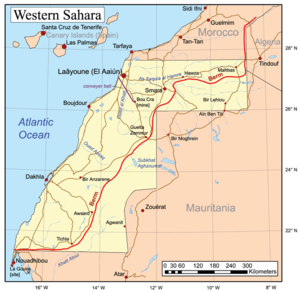Southern Provinces

 |
| This article is part of a series on the politics and government of Morocco |
|
Constitution |
|
Monarchy |
|
Government
|
|
Judiciary
|
|
Divisions
|
|
Elections
|
|
Foreign policy |
|
| Part of a series on the |
| Western Sahara conflict |
|---|
 |
| Background |
| Disputed regions |
| Politics |
| Rebellions |
| Issues |
| Peace process |
The Southern Provinces or Moroccan Sahara are the terms used by the Moroccan government for Western Sahara. These two official Moroccan denominations explicitly include all of Western Sahara. The Moroccan government favours "Southern Provinces" for its geographical obviousness, and because of the sensitivity of the word "Sahara" in Morocco.[citation needed] A frequent use of the term "Southern Provinces" is found for example in Moroccan state TV (weather forecasts, displayed maps on the news, government statements,...etc.).
The Moroccan government controls and administrates about two thirds of Western Sahara (the part west of the Moroccan military berm) and all the oceanic coasts of Western Sahara, government and private companies exploit coastal areas for fishing and the land areas for phosphate mining. The Polisario Front controls the remaining third, which is isolated from the ocean, mostly empty of any population, dry, and unfit for conventional urbanization or any basic economic activity.[citation needed]
The two thirds of Western Sahara that are controlled by Morocco are treated by the government as normal Moroccan territory. The government conducts various economic and social development programs and includes these "Southern Provinces" in the national budget of government funding, national sport competitions, education programs, and national parliamentary elections. Following the Green March and the Madrid Accords signed with Spain and Mauritania in 1975, Morocco took control of Saguia el-Hamra, and the northern part of Rio de Oro, while Mauritania took control of the remaining part of Rio de Oro, renamed as Tiris al-Gharbiyya.
A locally based Sahrawi national liberation movement, the Polisario Front launched a guerrilla war, with the crucial financial and logistical backing of Algeria and Libya, aiming to win independence of the territory under the "Sahrawi Arab Democratic Republic" (SADR). Following bloody clashes with the POLISARIO troops (SPLA) and deteriorating ties with Algeria, Mauritania pulled out in 1979 and gave up its share in the Western Sahara in order to avoid further complicated conflicts with the Sahrawi Republic, Algeria, and Morocco. Morocco then seized the opportunity and took control of the remaining part of Rio de Oro as well, which had been recognized by the Moroccan regime as Mauritanian a few years ago.
Since a United Nations-sponsored cease-fire agreement in 1991, about two thirds of the territory is at present administered by Morocco, including all the sea coasts, due to the construction of the Moroccan Wall. The Polisario Front control most of the remainder, which is almost unpopulated.[citation needed] POLISARIO's army is considered incapable of covering the vast one-third of Western Sahara, east of the Moroccan military berm.[citation needed] Moreover, most of Polisario's army is thought to be concentrated in the Tinduf area inside Algeria, safe from the long arm of Morocco's superior artillery and air force.[citation needed]
The cease-fire line corresponds to the route of the weaponized Moroccan Wall (the military berm). Both sides claim the territory of Western Sahara in its entirety. The Sahrawi Arab Democratic Republic had been recognized by 84 nations, and is a full member of the African Union, but not of the UN. Moroccan territorial integrity is implicitly recognized by the Arab League with strong reservations from Algeria and Syria.[citation needed]
Administratively, Morocco divided the territory under its control into administrative units (wilayas). Flags and coats of arms were created for the three wilayas of Boujdour,[1] Smara and Laayoune.[2] There were further changes in the territories in 1983, with the area becoming four wilayas through the addition of Dakhla.[3] In 1990 Wadi al-Dhahab (Rio de Oro) was added.
Morocco has assigned a special satellite TV channel for the "Southern Provinces", called Laayoun TV.[citation needed]
References and notes
- ↑ "Boujdour province, Morocco". crwflags.com. Retrieved 2007-03-20.
- ↑ "Laayoune province, Morocco". crwflags.com. Retrieved 2007-03-20.
- ↑ "Dakhla (Oued Eddahab-Lagouira) Province, Morocco". crwflags.com. Retrieved 2007-03-20.